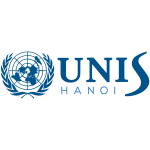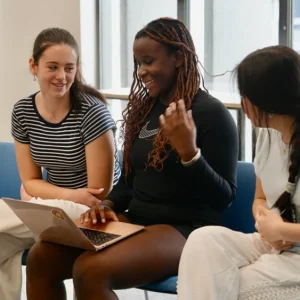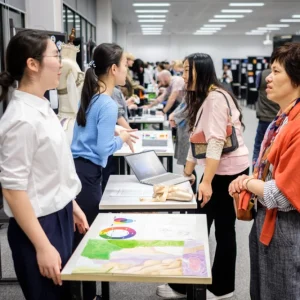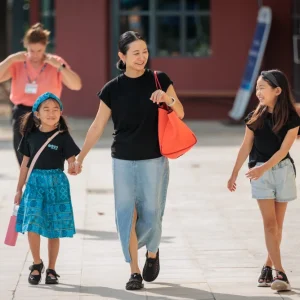A positive learning environment requires deliberate effort to cultivate an atmosphere where learners feel safe, supported, and motivated. This article explores 8 effective strategies to establish an engaging environment, drawing on educational principles and practical examples.
It also highlights the significance of creating a nurturing space for children’s academic and personal development, with insights from the United Nations International School of Hanoi (UNIS Hanoi).
Importance of a Positive Learning Environment
A positive learning environment enhances academic achievement, encourages peer support for students with disabilities, and fosters constructive interactions among students, teachers, and parents.
Positive environments create a healthy balance between mental health and academic goals, fostering autonomy and responsibility in students’ learning. This self-directed approach sets a strong foundation for the school year and promotes overall development.

In contrast, students struggling to adapt to a learning environment may feel frustrated, show behavioural issues, and disengage with their school community. This issue may decrease parental engagement while increasing teacher stress, contributing to burnout. Stress can physiologically affect students’ ability to learn.
By fostering positivity, we can address such issues and create an environment where students feel appreciated, secure, valued, motivated, and eager to learn.
8 Ways to Create a Positive Learning Environment
Fostering a positive learning environment demands a blend of structure, empathy, and engagement. Below, we outline 8 strategies for promoting positivity and supportive engagement in your students’ learning experience.
1. Get to Know & Address Student Needs
Understand your students’ unique traits—such as their interests, cultural background, and learning preferences—to support their education. Teachers can achieve this through conversations, journal prompts, or attending extracurricular activities.
Addressing psychological needs like security, belonging, and competence reduces disruptions and enhances engagement. Asking students what a positive environment means, perhaps a calming reflection corner, further tailors support.

UNIS Hanoi prioritises understanding each student individually. Fostering personal growth and nurturing curiosity is a cornerstone of our IB curriculum, supplemented by our diverse Student Support Services, including counsellors and learning specialists for tailored support.
Through class meetings and a Multi-Tiered System of Supports (MTSS), we attend to a child’s physical, social, and emotional needs to ensure their voice is heard, creating a positive learning environment. Our collaborative approach ensures children thrive, reflecting the school’s commitment to nurturing responsible global citizens.
2. Organise the Physical Environment
A well-structured classroom reduces stress and enhances comfort, aiding concentration. Assigning seats, establishing clear routines for handing in work, and ensuring the board’s visibility provide order.
The aesthetic also matters – soft lighting, personal touches, and positive posters can reflect a welcoming tone, helping students feel at ease and connected to their surroundings.

UNIS Hanoi exemplifies this through our thoughtfully designed campus. Among the upgrades to our Elementary School classroom are the installation of modern lighting and furniture and the student-friendly, flexible acoustic panelling that transforms the classroom into a stimulating environment.
The enhancements to our playground provide shaded areas for safer play, demonstrating our commitment as a school to a supportive physical learning and wellness environment, and reflecting our holistic approach to education.
3. Encourage Teamwork & Collaboration
Collaboration boosts engagement and teaches valuable social skills. Set clear expectations for group tasks, explaining their purpose, and form groups based on varied abilities or interests to ensure all contribute. Depending on the complexity of a task, smaller groups (3-4) encourage interaction, while larger groups (5-6) bring different perspectives.

Teamwork and collaboration are inherent in our IB Learner Profiles at UNIS Hanoi. Our curriculum drives community sense through interactive projects that tackle real-world issues, integrating classroom work with real-world problems.
Balancing group dynamics, we help students strengthen their critical thinking and interpersonal skills, reshaping their educational experience. Parents can also support this by discussing teamwork’s value with their children, aligning with UNIS Hanoi’s focus on responsible citizenship and real-world connections.
4. Involve Students in Class Decisions
Empowering students to share opinions builds confidence and strengthens their connection to learning. Offer choices in approaching tasks, encouraging them to take risks and voice ideas. This student-centred approach fosters ownership, increasing effort and participation in class activities.

As part of the IB program at UNIS Hanoi, student-centred learning fosters active participation and allows children to share their thoughts and opinions on their educational experience. We incorporate this method into the school’s discussions, hands-on activities, and other teaching methods that appeal to different learning styles.
Meanwhile, our commitment to partnerships with parents ensures student input shapes their education. This approach demonstrates our school’s vision of fostering students as “Thinkers” and “Inquirers,” who take initiative and meaningfully engage with their surroundings.
5. Prioritise Social Emotional Learning
Social-emotional learning (SEL) actively prepares learners to manage emotions and other problems, strengthening mental health. Using SEL methods – through discussions or dedicated activities – encourages children to cultivate resilience and empathy for their well-being and academic success.

UNIS Hanoi’s Student Support Services, including counsellors and psychologists, prioritise SEL within a holistic approach. The MTSS framework offers tiered support, addressing emotional needs alongside academics.
Parents can reinforce this by discussing feelings at home. This complements UNIS Hanoi’s mission to develop “Balanced” and “Reflective” learners who thrive emotionally and socially, preparing them for lifelong success.
6. Give Personalised Feedback on Assignments
Tailored feedback demonstrates care and motivates students by highlighting strengths and areas for growth.
Beyond marking errors, a personal note addressing the student by name – e.g., “Dear Sophie, your creativity shines here. Consider refining this section…” – encourages them to reflect on and apply your guidance.

UNIS Hanoi integrates this practice within our IB curriculum, which stresses individualised learning processes. Teachers provide detailed, constructive feedback, supported by our MTSS framework’s data-driven approach, ensuring progress is tracked and celebrated.
Moreover, parents can ask for feedback during conferences, supporting UNIS Hanoi’s partnership approach, which helps children internalise guidance and excel academically.
7. Be Open to Students’ Feedback
Inviting students to share thoughts on teaching methods or classroom management offers valuable insights and builds trust. Acknowledging mistakes – such as a simple error on the board – and discussing them openly models a growth mindset, showing that learning from setbacks is valuable.

At UNIS Hanoi, we embrace openness as part of our IB principle of reflection. Regular communication with students and parents through conferences and workshops ensures their perspectives shape our practices.
This vulnerability strengthens our community, reinforcing a culture where growth and mutual respect thrive. Parents can encourage children to voice opinions and ask about their school experiences, ensuring their voice informs ongoing improvements.
8. Foster Positivity Through Curriculum and Teaching Methods
A relevant curriculum keeps students engaged by linking lessons to their lives. Adapting teaching strategies to reflect their cultural and personal contexts makes learning meaningful, sustaining their emotional investment throughout the year.

UNIS Hanoi’s IB curriculum connects classroom experiences to global realities, integrating Vietnamese culture and media literacy to enrich learning. Our interactive, interdisciplinary approach – supported by co-curricular activities – ensures positivity permeates education.
By respecting our diverse community, we create a dynamic environment where students feel inspired and valued. Parents can discuss these connections at home, enhancing UNIS Hanoi’s aim to make learning meaningful and prepare children to contribute positively to the world.
Nurture Your Child in a Positive Learning Environment at UNIS Hanoi
Fostering a positive learning environment is vital for your child’s academic success and personal growth. We embed these principles within our IB curriculum and supportive framework at UNIS Hanoi to ensure student success.

We invite you to join our community by applying for the 2025-2026 academic year. Visit our online application portal or contact admissions@unishanoi.org for personalised guidance. Together, we grow your child in a nurturing, world-class setting!
Author Profile

- UNIS Hanoi is ever-evolving, but one thing that remains is our passion to nurture and equip students to be agents of change for a better world.
Latest entries
 Calendar, News and Publications30 Oct 2025What is an IB School? A Complete Guide for Parents
Calendar, News and Publications30 Oct 2025What is an IB School? A Complete Guide for Parents Calendar, News and Publications29 Oct 2025School Tour at UNIS Hanoi – A Comprehensive Guide for Parents
Calendar, News and Publications29 Oct 2025School Tour at UNIS Hanoi – A Comprehensive Guide for Parents Calendar, News and Publications28 Oct 2025How to Choose the Right School for Your Child: The 2025 Guide
Calendar, News and Publications28 Oct 2025How to Choose the Right School for Your Child: The 2025 Guide Calendar, News and Publications27 Oct 2025Student Recruitment at UNIS Hanoi: A Parent’s Comprehensive Guide
Calendar, News and Publications27 Oct 2025Student Recruitment at UNIS Hanoi: A Parent’s Comprehensive Guide